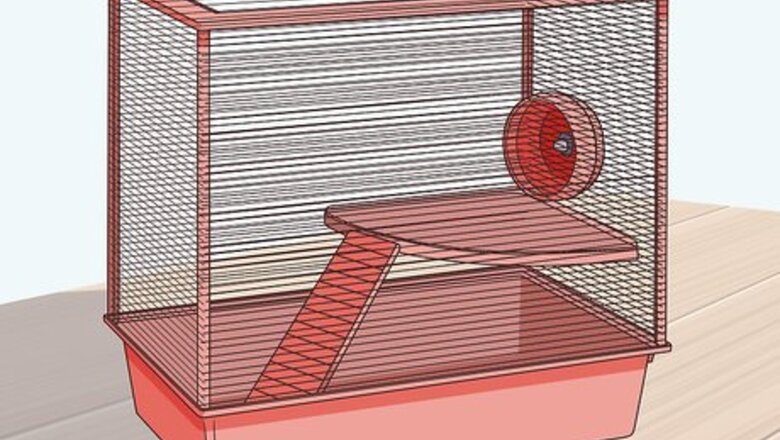
views
X
Research source
Make sure to provide the proper basic care, understand your rat’s behavior, and spend a lot of time with it. With some patience, you will have a unique pet that will love spending time with you.
Providing Basic Care

Provide a roomy cage. You will need a cage that provides at least two cubic feet of space per rat. While this is a good rule of thumb for most rats, there are some situations where rats will require more space. For instance, if you have a larger rat or multiple rats that are sensitive about sharing elbow room, such as many intact male rats, you may want a larger cage. Keep in mind that your rat is going to spend the majority of their life in their cage so giving them a spacious environment will help keep them happier when you are not able to take them out for play. If you have two rats, it may be better to keep them separate, especially since 2 male rats can get territorial.
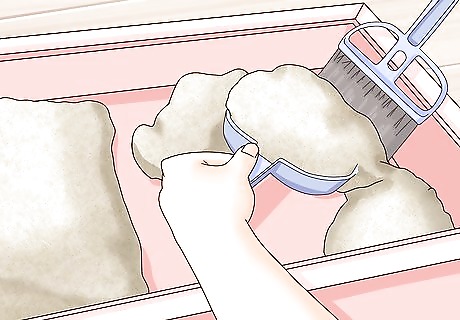
Keep the cage clean. You should be cleaning your rat’s cage at least once a day. For your daily routine, scoop out any visible excrement and wipe down plastic or metal parts of the cage with a baby wipe or wet paper towel. Be sure to use non-toxic, pet-safe cleaning products or regular dish soap. Use rat litter or fleece blanket to line the bottom of the cage. Completely empty out and replace the litter at least once a week. Woodchips and dusty litter should be avoided due to the sensitivity of your rat's respiratory system especially pine, as it is toxic . Litter made from old newspaper is most ideal (ref: veterinarians), while clay litter is high in dust (despite '99.9% dust-free' labels). You can check the dust content by placing the litter in a plastic sandwich bag, shaking the bag and observing how much dust sticks to the inside of the bag. Refrain from using towels and similar fabrics in your rat's cage since your rats may end up swallowing string fibres from these fabrics, which can be harmful. Fleece is a wonderful cage liner, is reusable and is found in most dollar stores. Cloth bedding (i.e not sleeping bags or hammocks) should be changed at least once a week. If you can smell pee or other 'rat smells' in their cage or when you enter the room, then it is time to change the bedding. Again, it's well known that rats have very weak respiratory systems, so keeping your pets around smelly bedding or litter (smelly means bacteria!) can be very harmful. You should do a thorough cleaning at least once a month that includes wiping down all metal and plastic parts of the cage (bars, litter box, cage base, etc.), washing out the water bottles with soap and water, and washing any sleeping bags, hammocks, etc. Empty water bottles and refill with fresh water at least every other day. Remove any fresh food (fruits, veggies, etc.) that is not eaten. It will rot and attract bacteria. Also remove any food pellets or dried foods that have become wet.

Feed your rats regularly. Water should be readily available at all times as rats can easily dehydrate. Have two water bottles present at all times so food and water dominance issues do not arise. Likewise, when feeding your rats snacks (veggies, seeds, fruits, etc.), it is a good idea to make two separate but equal piles. Do not give one rat something that you do not give the other rat. The rat that is missing out on the snack will smell it on the other rat and aggression can arise. The common staple food for rats is a standard lab block or lab pellets. These pellets are designed specifically to meet the dietary requirements of rats and can be supplemented with nuts, fruits, veggies, oats and other fun snacks. Oxbow rat food is a wonderful staple pellet. Do not feed your rats rabbit, hamster or other small animal pellets as the nutritional requirements of each small animal are different. It can be very difficult to meet the nutritional requirements of your rat by creating your own diet for them and missing nutrients can be detrimental to your rat's health. For this reason, it is often better to use a store-bought pellet as the staple of your rat's diet and supplement their diet with other foods. Avoid the colourful pellets at the pet store - they may seem tastier but are not often as wholesome as Oxbow or similar, and the artificial dyes can cause stomach upset. Start by feeding your rat one table spoon of these foods twice per day. Once it gets used to food being readily available, it will learn that it doesn’t need to overeat and you can leave a small bowl of food in there at all times.

Add some variety. Rats can eat a wide variety of meats, fruits and vegetables. Try to mix in a few more wholesome foods along with the typical rat food you buy at the pet store. You can add in these foods as often as you’d like and should include roughage vegetables at least once a week.. Do not feed your rat too much protein as the pellets already have enough protein in them. Meats should be limited to one small serving once a week or very small servings (e.g. one dog kibble) a couple of times per week. Strawberries, grapes, apples, blueberries, leafy greens, squash, cucumber, potatoes and sprouts are all excellent options for adding some variety to your rat’s diet. Once your rat is old enough to self-regulate their food intake (i.e. not over-eat), you can give your rats fresh veggies, oats and other snacks once a day. Remember to give them a nice variety so they do not get bored! For example, a yummy daily rat salad may consist of 1 bok choy leaf, 2 dandelion leaves, 1 collard green leaf (depending on size), kale and half a slice of apple or a couple of blueberries. Get to know your rat; some rats may eat everything that is in front of them while other may stop eating when they are full. You do not want your rats to fill up on veggies and not eat their pellets but if they are doing a good job of self-regulating, you can give them more than a couple of leaves and remove any uneaten leaves the next day. Meats like chicken, beef, tuna and liver are also great for rats. Make sure you mash them up a bit before serving so they’re easier to digest. There are a lot of great resources on rat diets online; be sure to read through a few before deciding on what you will allow your rat to have as you may notice some contradictions in the do's and don't's of feeding rats. For example, mangoes are toxic to male rats but can be fed to female rats. Green beans are healthy for rats but only if they are cooked; do not feed your rat raw green beans. Likewise, do not feed your rat raw brussel sprouts. Monitor your rat's weight to make sure that its weight isn't interfering with its ability to move around. That's a clear sign your rat is overweight.

Avoid certain foods. Despite the stereotype, rats should not eat cheese as most rats are lactose intolerant. You should also avoid dried corn, oranges, licorice, red cabbage, rhubarb and human junk foods like potato chips and candy. All of these can be toxic for your rat.

Avoid using string or zip-ties to suspend baskets, toys and other items in your rat's cage. Instead, check out your local dollar store for circular, metal shower curtain rings. These rings are fantastic because they are sturdy and don't pose a choking hazard!
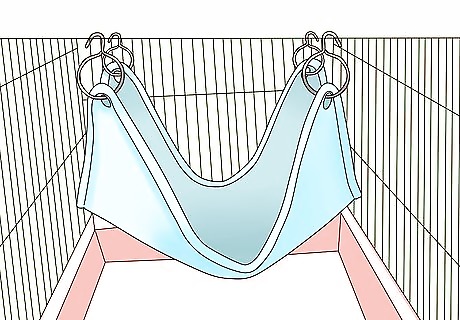
In general, the dollar store is a wonderful place to find items to decorate your rat's new home. If you are finding that hammocks and sleeping bags are on the pricey side, try using the shower curtain rings to suspend a plastic basket from the inside wall of the cage. Fill the basket with fleece pet blankets and your rats will have a very comfy nest! Levels for rat cages can also be quite pricey; instead use small, plastic organizers, dog toy ropes, pet blankets, log houses, etc., all of which can usually be found at the dollar store! Keep in mind though that your rats will chew everything!

Make sure all levels, baskets, hammocks, etc. are very secure. Rats will chew through fabric ties and anything you use to suspend or secure levels, etc. could give way at any time! Try securing levels or anything climbable in two ways (i.e. double up on the number of rings holding the basket to the cage or secure the basket to the cage wall and another object so that if one restraint gives way, the basket will not fall to the bottom of the cage).

Check that your rat cage has a solid bottom. Wire bottoms are very hard on rat feet and can cause tremendous pain. If your cage has a wire bottom, line it with something smooth and solid such as plastic placemats or cardboard. Place a fleece blanket over top. If you are using cardboard, you should dispose of the cardboard each week. If you are using placemats or something similar, you should wash these each week (rats won't pee in their nest/bed but they will pee on the floor of their house; it's important to always clean up pee).
Socializing Your Rat
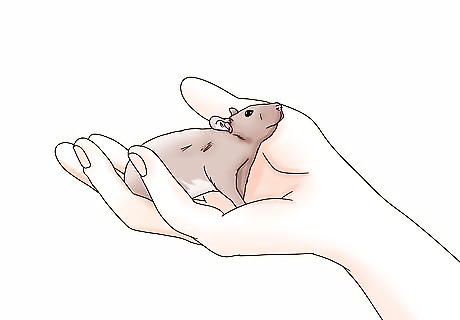
Like dogs and cats, rats are much easier to socialize when they’re younger. If you have your choice and are looking to interact with your rat or introduce a new rat to your current rats, pick one that is under 6 months old. After this age, they begin to develop their social behaviour and if they live in the wild or without much human contact, that is what they’ll be used to.. That said, do not overlook older rats that are in need of a new home! All rats are wonderful, some just may take longer to be comfortable in their new surroundings. Older rats can be socialized with the same methods but you’ll need to be more patient as it will take them longer to trust you.
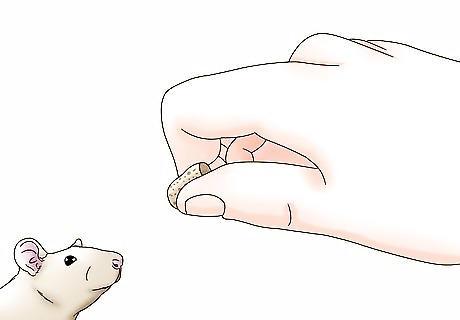
Offer treats from your hand. Rats will come to trust your hands if they associate them with food. Start by hold the food with your fingertips. After you’ve fed it from your fingertips a few times, hold the food in the palm of your hand and let the rat sit in your hand as you eat. Eventually, it’ll instinctively walk onto your hand anytime you hold it out.

Speak softly. Rats, much like dogs, have the ability to differentiate voice patterns. Try to repeatedly say its name softly over time. It may learn to remember its name and come to you when you say it as long as you reward it with treats..Remember to reward your rat for coming to you when called with a small piece of a snack. Because a rat’s eardrums are so small, it won’t be able to differentiate sounds that are too loud. Try whispering with your mouth close to its ear.
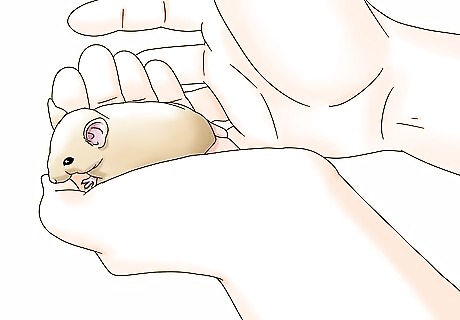
Hold your rat correctly. Never squeeze your rat and avoid restraining it for more than a few seconds at a time. Keep your hands open and let the rat move around at will. By spending time in your hands, your rat will get used to your scent and bond with you. Pick up your rat by placing your hand under its belly. Try to use two hands when picking it up. Putting your rat on its back so that its belly is exposed is a sign of dominance and can be stressful to your rat, especially when there is no real reason at that particular moment for you to be asserting dominance. Once it’s used to being held, try to simply hold your hand out and let the rat come to you.
Playing Games with Your Rat

Make food fun for your rats. Remember that the are very intelligent animals and can get very bored. One fun game is to put corn, peas and diced carrots (no beans) into a bowl of water for your rats so they can splash in the water and 'bob' for their snacks. This game is especially nice on hot days. It is a good idea to use a heavier dish such as glass or ceramic so your rats do not accidentally spill the water onto the floor. Do not use a dish that the rats could get trapped in and always supervise them while they are playing this game!
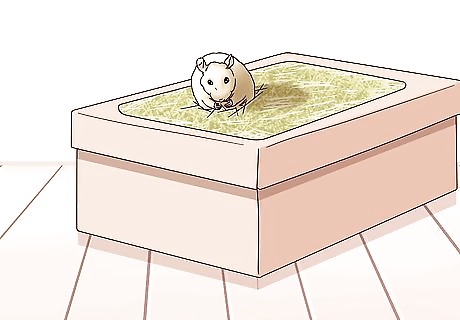
Another game that is fun for your rat engages their natural foraging behaviour and does not require constant supervision. Fill a shoe box or any box that they can easily climb in and out of (i.e. 6 inches or less in height) with grass hay (do not use Timothy hay or alfalfa as you are using the hay for the game but do not want them to eat a lot of it - read up on rats and alfalfa). Sprinkle some dried oats, seeds (unsalted) or other small, non-sugary snacks onto the grass hay and mix it slightly so that bits of snack can be found throughout the hay. Your rats will love searching for their favourite dried snacks!

A hanging snack ball is also a great way to engage your rats during snack time. These are hollow, cage-like balls that allow you to put fruits and veggies inside the ball and hang from the top of their cage so that your buddies have to work a bit harder for their snacks!
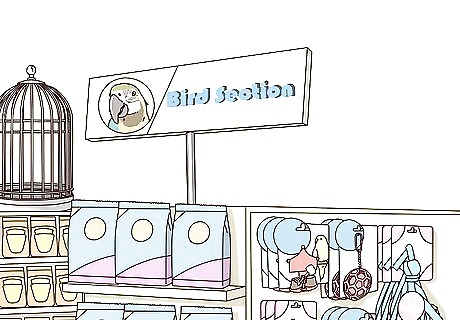
Check out the bird section of your local pet store or online for fun games. Oftentimes, the birds have better toys than the small animal section!

Build mazes. Rats are known for their ability to take logical approaches to solving mazes. This is a great way to exercise your rat’s mental ability. You can make mazes and obstacle courses out of cardboard boxes or toilet paper tubes taped together. Rats are climbers so try to stack the boxes up. Make sure the climbing structures are sturdy enough to not to collapse under your rats' weight. If you are feeling ambitious, try creating obstacle features like hoops, see-saws, ramps, weaving poles and tunnels. Use treats or moving objects to lead it through the maze. Rats will instinctively chase something that moves quickly so pulling a string or rolling a small bouncy ball will also work.
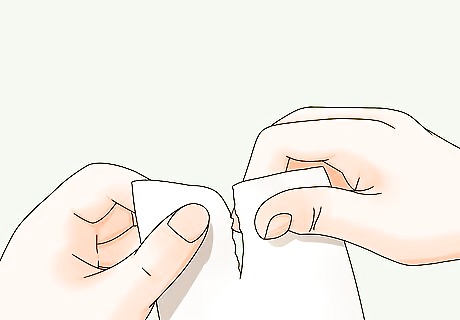
Tear up some paper. Try tearing some paper into strips and giving your rat one piece at a time. It will grab the paper, stash it away and return for more. This will build trust by teaching your rat that you have and want to share treasures it enjoys.

Play hide-and-seek. If you hide behind something, your rat might come looking for you and get excited when it finds you. It’s best to do this after you’ve hand-tamed your rat so it knows your scent and can try to follow it. Make sure you’re not too far away or it might get lost.

Let it play in the dirt. Rats like to play in the dirt and will dig in your house plants if they find them. Give them a digging box full of sterile soil that will allow them to dig and forage without ruining your plants or eating a poisonous fertilizer. Put a large towel or outdoor tablecloth on a flat surface underneath the box. You can use a shoe box or anything of similar size. Add soil to the box and bury treats or toys into the dirt. If your rats tend to get sick often, it might be best to avoid this game.




















Comments
0 comment